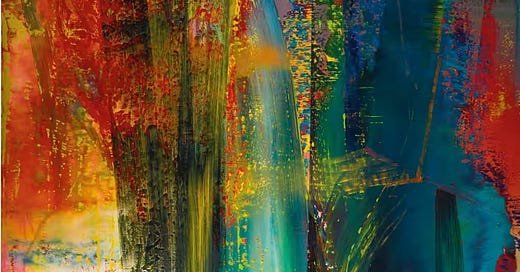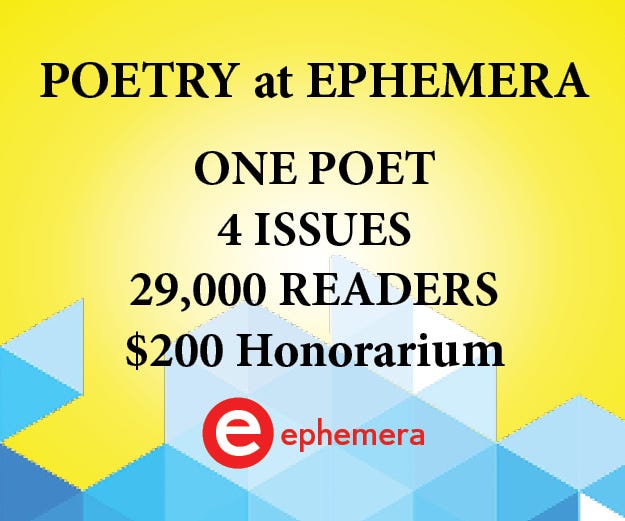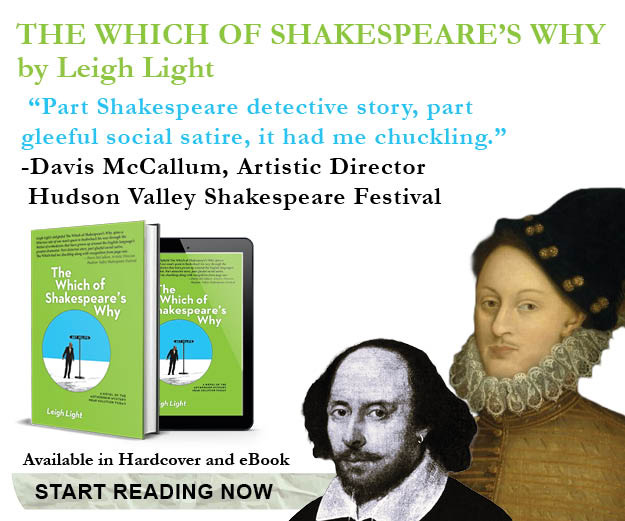Welcome to the Ephemera Newsletter, Hevalên! (Kurdish for “friends”)
A third issue basking in the poetry of Robert McBrearty, Ephemera’s poet for the month of May! If you haven’t yet, please check out his artist statement and bio on this dedicated post. We thank you for your presence.
On to our standard content matters: Won’t you please check out last week’s issue if you missed it.
PLEASE REVIEW OUR SPONSOR!
After being sent a copy, we were intrigued and entertained by this book and agreed to promote the work in the newsletter. Anyone who’s ever read a play by Shakespeare and wondered about the pseudonym will be immediately gratified by the introductory and parting notes to the reader that more formally access the who and why of the novel, addressing the politics of Shakespeare’s identity as well as the evidence. In the end—and we’ll let you read it—the author’s conclusion (pen name deployed in apropos fashion) fascinated us. And the novel as well. The notes and novel work together like a Pale Fire—as in they inform each other, though in The Which of Shakespeare’s Why the notes are indeed separate and not a part of the fiction, are meant as non-fiction, essays by the pseudonymous author who apparently serves in academia somewhere. We hope you’ll take a look for yourselves.
From the publisher:
The controversy over who really wrote Shakespeare’s plays has been around almost since they were written. Was the genius behind the plays really that obscure glover’s son from Stratford? Or was it someone else entirely—a man whose class, background, education, and peculiarities make him a more than plausible candidate?
In The Which of Shakespeare’s Why, a 21st-century playwright named Harry Haines makes the case for a major contender via a play he himself is writing for a struggling New Jersey theatre company. Faced with strong disapproval from the “Stratfordites” and with the backing of supporters that sometimes takes some unusual forms, Harry attempts, against great odds, to get the play written and staged.
In the process he has to overcome his own doubts, stay on the right side of the right people, keep his romantic life under control, and deal with not only a difficult actress or two but a flock of opinionated Rockettes. Part hilarious farce, part serious critical examination, The Which of Shakespeare’s Why provides a thought-provoking look at a controversial puzzle with a surprising, ingenious, and wholly satisfying ending that Shakespeare—whoever he was—would have given a standing ovation.
In Brief…this week’s features:
Thoughts on Gerhard Richter and stylistic range.
Ephemera Dec.1, 2022 we also examined Richter. Here to read.
Listening to the multifaceted electronic ambient compositions of Kiasmos.
May’s poet, Robert McBrearty and his third of four poems, “Lounging with Bartleby.”
Our weekly lists:
3 magazines with open calls
3 awards/prizes
3 recent job listings for editors and writers.
SPONSOR: From Simon & Schuster publishers, The Which of Shakespeare’s Why, a novel about a playwright who attempts to answer the question of Shakespeare’s true identity while putting on a play of his own under immense pressure from funders and performers alike.
More ephemera:
Last Week’s Issue.
Merci. Danke. Kiitos. 고마워 Go-ma-wo. Cảm ơn. Xiè xiè.
Ephemera
Dear Readers,
Having recently watched the movie Oppenheimer, we’re thinking of techniques that contributed to the narrative rush of the film, what technique might it have been, at least in small part, that enabled the film to garner the best picture award from the Academy. One of Christopher Nolan’s closely held and often utilized film making go-to’s is the disruption of time, leading viewers in the present of the film with unexplained scenes that represent a time in either the past or future. In the moment, the future or past scene is insufficiently explained which can generate an intrigue in the viewer. It’s a gambit, and by Nolan’s hand, can become nonsensical (as in his film Tenet), ponderous (as in Inception), striking and the entire purpose of the flick (as in his quite successful Memento), or emotionally charged (as in Interstellar). In Oppenheimer, which we watched on a plane, the movement of the film deploys the very standard film practice of moving time forward and along at varying speeds that sort of get explicated by contextual clues, and, usually, it’s so fluid that we as viewers hardly notice. It’s simply the grammar of movies we learn at a young age. It’s film language. Nolan has the ability, however, to highlight that grammar in a similar way to poets and writers who call attention to the bones of the work for discrete and, hopefully, powerful effect.
“The first impulse towards painting, or towards art in general, stems from the need to communicate. … Without this, all work would be pointless and unjustified, like Art for Art’s Sake.”
—Gerhard Richter
We’re thinking of a few key moments in the film, particularly, the scene when Oppenheimer exchanges an erudite word or two with Einstein that we cannot hear, a scene we see several times at various parts of the film, preceding and after the moment as it occurs chronologically, culminating in a final flashback that reveals the words at which point, having watched the whole film, the importance and weight of the words might best be felt. A gambit for sure, but it works. And, while it seems to be a sort of canard as evidenced in interviews and criticism within the art that film is uniquely positioned, if not exclusively so, to deal with and manipulate time, we’re not convinced. Yes, if you’re talking about visual art, probably, but it very quickly occurs to us that poets dissect and manipulate time convincingly and we often barely notice, from a tiny inkling to a huge moment to the past and future, jumping perspectives or not, whatever is needed to create the emotional effect. Whether poets learned it from traveling story tellers or vice versa or maybe they spawned one in the same, creative storytellers have been disrupting and augmenting time to suit their purposes forever.
We’ve seen a lot of historical work over the years, from epic poems to multi-generational tales to historical fiction. Often, they’re predominantly or entirely linear. Oppenheimer makes us think that we can do time disruptions more experimentally, combine them with a subject matter that has gravity. We can consider using the past or future more readily even in literary, serious work. Perhaps more forcefully, we should include this skill in our repertoire to be deployed as we need it, as it might bolster or sharpen our work. We tend not to reach for this option. But it’s worth considering how to tease future or past events, revisiting, and then delivering a moment of pent up emotional or narrative release.
Sipasdarî!
(Gratitude)
Poetry by Robert McBrearty
Lounging With Bartleby It cost me everything to mope but I held firm. Do you want to? No, I don’t. You might detect in my faint smile my turn of hip a certain drooping lip if I let slip the fact that I was saying No. While others bustled With their work And cool ambitions Bartleby and I lounged languidly on the couch preferring not. Some call it giving up, but I prefer to call it rest, a winter’s slumber. Shake my shoulder in the spring and I might rise.
Or please join us as paid subscribers:
Featured Music: Kiasmos
Keep reading with a 7-day free trial
Subscribe to Ephemera to keep reading this post and get 7 days of free access to the full post archives.





